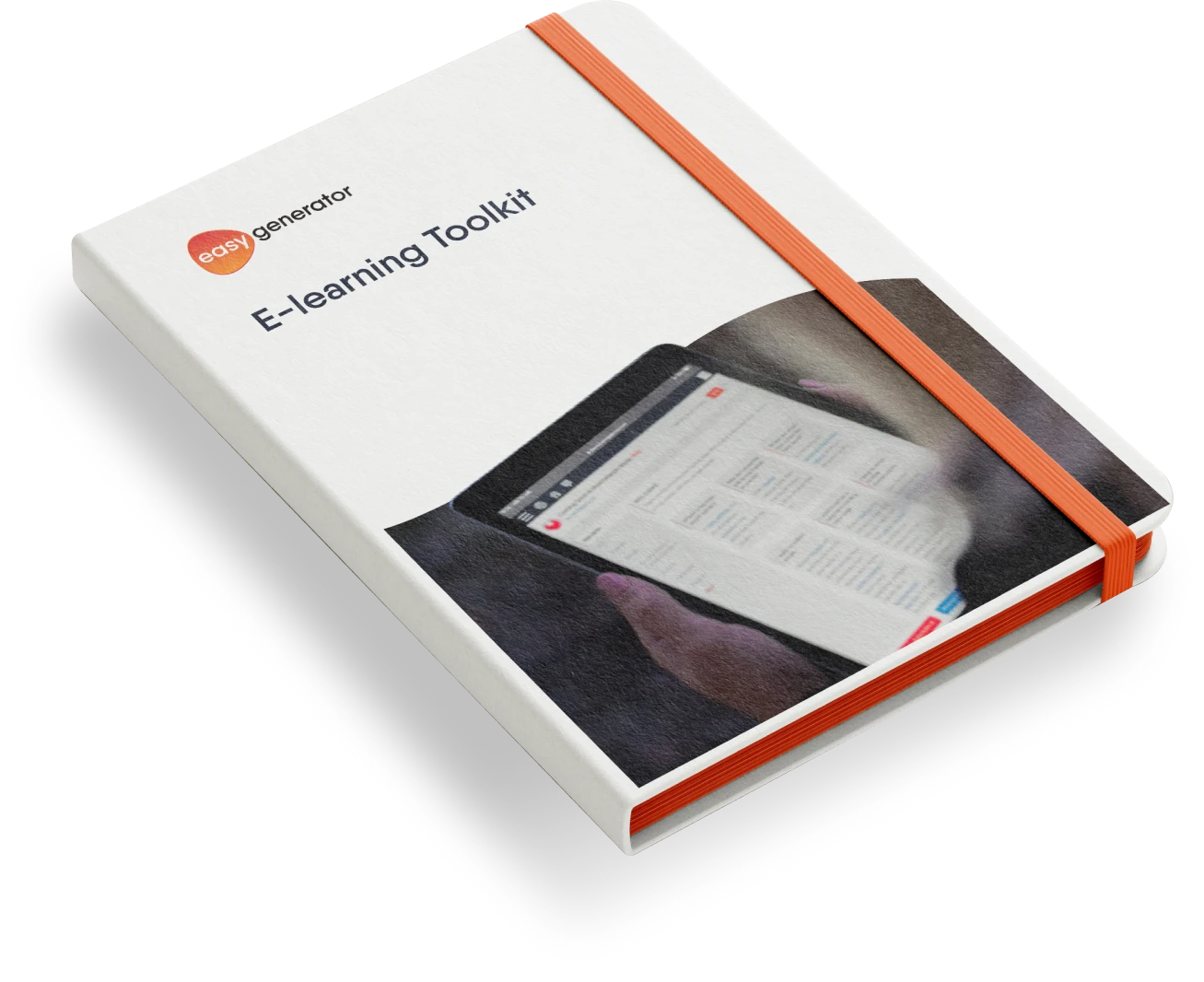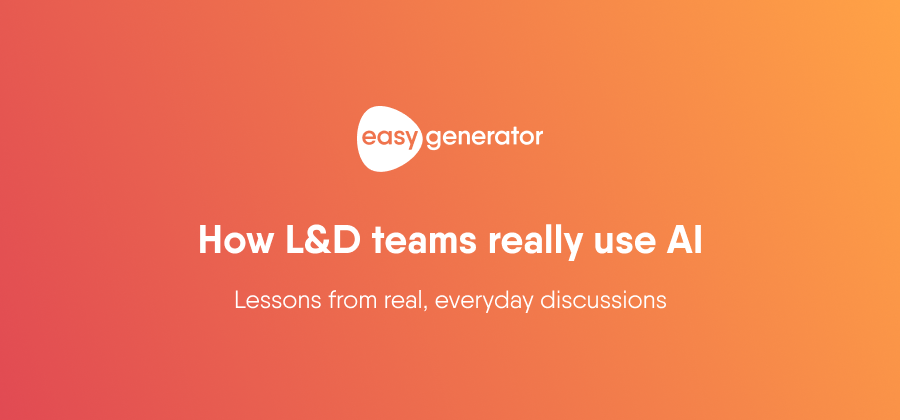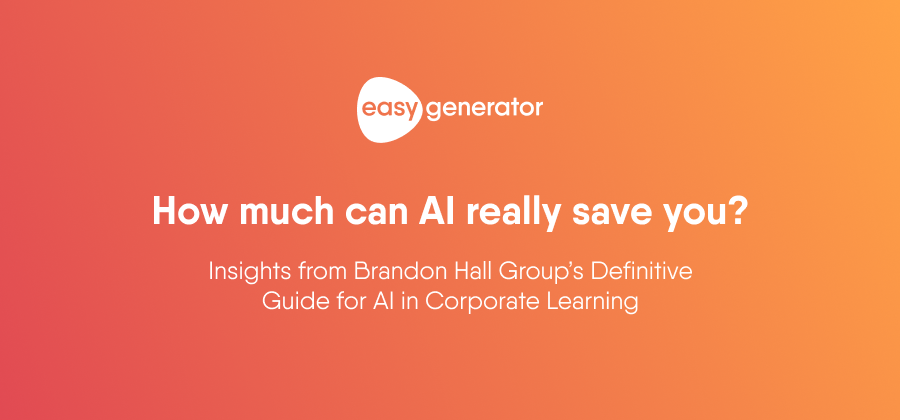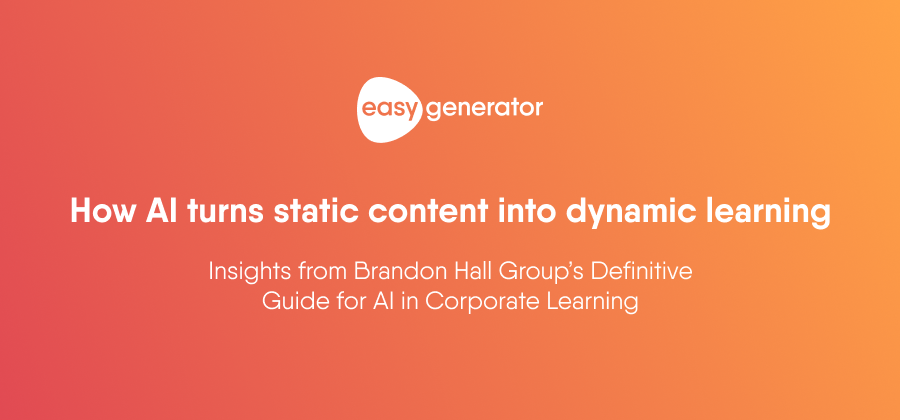9 proven ways to speed up e-learning development
Developing e-learning content can take a lot of time, but it doesn’t have to. With the right strategies, you can speed up your e-learning development while keeping your courses effective and engaging.

Creating effective e-learning can feel like a complex, time-consuming task.
We have some good news: you can speed up your e-learning development process without sacrificing quality.
In this article, we’ll share simple strategies to help you create courses faster while still delivering effective training.
1. Let SMEs take the lead with Employee-generated Learning
One way to speed up e-learning development is by embracing Employee-generated Learning.
This approach allows subject-matter experts (SMEs) to create and maintain training content. Since SMEs are the ones closest to the work, they can translate their knowledge into training materials quickly and ensure it stays relevant.
A great example of a company using Employee-generated Learning to speed up e-learning development is Danone. Danone decided to enable its global teams to create e-learning content independently. This shift allowed them to produce and maintain learning materials much faster than relying on external vendors or a centralized L&D team. In two years, more than 1,000 employees were creating on-demand training, dramatically cutting e-learning development time for the company.
How to get started:
- Identify SMEs in your teams who can share their expertise.
- Provide intuitive authoring tools that simplify content creation.
- Offer a quick training session to show SMEs how to use these tools.
- Set up a shared space for uploading and updating e-learning content.
2. Break the work into manageable steps with agile development
Agile methodologies help teams work smarter by dividing e-learning development into smaller, manageable phases. Instead of creating the entire course at once, teams focus on one section, gather feedback, and refine it before moving on. This makes the e-learning development process much smoother and reduces delays from last-minute changes.
For example, a team working on a compliance course could spend two weeks building a single module, then share it with HR and legal for input. Incorporating feedback early ensures the next steps are aligned, so there’s no need for lengthy revisions later.
How to get started:
- Divide the project into smaller deliverables, like modules or sections.
- Hold regular planning meetings to set goals and gather feedback.
- Use tools like Trello or Asana to track progress and keep everyone on the same page.
- Adjust plans based on feedback after each cycle.
3. Use tools that make content creation faster
Your tools can make or break your e-learning content development process. Authoring platforms with user-friendly features like templates, AI assistants, and media libraries allow people to create e-learning content much faster.
For instance, De’Longhi provides its regional teams with a specific e-learning template for its product updates. This way, whenever the teams need to create custom e-learning for their market, they can get it done faster while following the same governance guidelines.
How to get started:
- Choose tools that are simple to use and include pre-built templates.
- Choose tools that have AI assistants built in.
- Train SMEs and team members on how to use the tools effectively.
- Organize a central library of images, videos, and other assets for quick access.
4. Speed things up with microlearning
Microlearning is all about delivering training in small, focused chunks. It’s faster to create, easier to understand, and ideal for covering specific objectives. Instead of a long course, you can build quick modules like videos, infographics, or quizzes that learners can complete in minutes.
For example, instead of developing a two-hour workplace safety course, you could create a series of short videos. Each video could tackle a topic like fire safety or ergonomics. This lets you launch the training in phases, so employees start learning sooner.
How to get started:
- Break down your training topics into small, focused objectives.
- Use simple formats like short videos, infographics, and quizzes.
- Make these modules accessible anytime in a central location.
- Ensure each module focuses on one clear concept or skill.
5. Leave complex training to live sessions
Blending learning formats can simplify your e-learning development process by narrowing down what needs to be created. Instead of designing e-learning modules that try to do it all—like interactive scenarios or role-playing—you focus only on the essentials. These include facts, processes, or steps, which can be quickly built using templates or straightforward tools.
More complex elements, like practicing skills or problem-solving, are moved to live sessions. Live sessions, whether virtual or in-person, are quicker to organize and deliver than designing advanced e-learning features like simulations. This way, you save time on content creation without sacrificing the depth of the learning experience.
How to get started:
- Build foundational training as self-paced e-learning modules.
- Move interactive or practice-based activities to live sessions.
- Use pre-designed templates for quick and consistent content creation.
- Gather feedback from live sessions to refine the e-learning basics.
6. Let regional teams handle localization
For global organizations, localization is key—but it doesn’t have to slow things down.
Letting regional teams adapt e-learning content for their local language and culture speeds up the process and makes the training more relevant to the audience.
Sodexo did exactly that. With a workforce that includes 130 nationalities, Sodexo’s global L&D team couldn’t keep up with the high volume of training requests—until it implemented Employee-generated Learning. Sodexo enabled its local teams to create region-specific training using Easygenerator. These teams could quickly develop just-in-time training materials, skipping lengthy translation and approval processes. Thanks to this strategy shift, Sodexo now produces learning modules 22 times faster.
How to get started:
- Assign localization tasks to regional teams familiar with the audience.
- Provide a clear framework to ensure quality and consistency.
- Equip teams with tools and resources for translation and adaptation.
- Review localized content periodically to maintain alignment.
7. Speed up reviews by involving your team
Quality assurance doesn’t have to rest on one person’s shoulders. Peer reviews let multiple SMEs and team members check content for accuracy and alignment. This not only divides the workload but also brings fresh perspectives to the training.
For example, if an SME creates a module on data privacy laws, a peer in the compliance team could review it for accuracy. Another team member could ensure the tone is clear and engaging. By sharing the responsibility, the review process moves faster.
How to get started:
- Assign specific reviewers based on their expertise.
- Give reviewers simple guidelines for what to look for.
- Use tools to track changes and feedback efficiently.
- Set clear deadlines for reviews to avoid delays.
8. Use learner feedback to keep improving
Your learners are one of the best resources for improving e-learning content. Regular feedback can show you what works and what doesn’t, helping you make quick updates instead of waiting for a major overhaul.
For instance, if learners report in a survey that the examples in a conflict resolution module aren’t realistic, you can update the scenarios to make them more relatable. This keeps the course effective without a complete redesign.
How to get started:
- Embed feedback surveys or forums at the end of each course.
- Monitor responses regularly and prioritize updates based on trends.
- Set up a process for SMEs to review and act on feedback promptly.
- Let learners know when updates are made—it shows you’re listening.
9. Create clear roles to avoid bottlenecks
Having clear roles and responsibilities makes the e-learning development process much smoother. SMEs can focus on their expertise—creating accurate, relevant content—while instructional designers refine it and add engaging elements.
For instance, an SME might create a financial compliance training module, and an instructional designer could add visuals or interactive elements to enhance it. By working together, both tasks get done faster.
How to get started:
- Clearly define the roles of SMEs and instructional designers.
- Train SMEs on how to create structured, organized content.
- Use collaboration tools to keep everyone aligned and track progress.
- Apply checklists to ensure consistency and quality in every module.
Conclusion
Speeding up e-learning development doesn’t mean cutting corners. It’s about working smarter.
Strategies like enabling SMEs to create content, streamlining localization, and breaking training into smaller modules can help you deliver effective training faster. These approaches save time, cut costs, and ensure your learners get the resources they need when they need them.
Now it’s your turn to put these strategies into action. Start with one or two that address your team’s biggest challenges. With the right tools and methods, you can transform your e-learning development process and deliver results faster than ever.
-
 14 day trial with access to all features. Start with variety of course templates.
14 day trial with access to all features. Start with variety of course templates. -
 Get unlimited design inspirations. Level up your courses.
Get unlimited design inspirations. Level up your courses. -
 Upload your PowerPoint presentations. Get instant courses created.
Upload your PowerPoint presentations. Get instant courses created.




